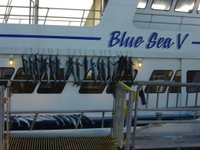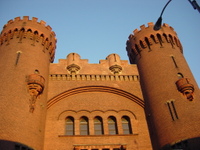
Here’s another great idea for a Brooklyn walk from Adrienne Onofri, author of WALKING BROOKLYN.
Last Sunday’s Times story about Brooklyn blogs, which prominently featured OTBKB and its founder, Louise Crawford, discussed the “underblogged” neighborhoods of our very bloggy borough. To give these communities a little blog coverage, let me tell you about some sights on the Walking Brooklyn routes. What’s mentioned here are just a few of the things to discover and enjoy while walking in these neighborhoods.
Bedford-Stuyvesant: New York City’s only landmarked tree, the
Magnolia Grandiflora…the statue of Robert Fulton that used to lord over
the ferry landing…a block of Hancock St. with several residences by
Montrose Morris, Bed-Stuy’s preeminent architect of the Gilded Age…the
Alhambra and Renaissance, Morris’ stunning apartment houses
side-by-side on Nostrand…a “medieval castle” built as the National
Guard’s 13th Regiment Armory.East New York: New Lots Reformed Church, built by Dutch farmers in 1823, with a graveyard full of names now found on Brooklyn street signs (e.g., Van Siclen)…the onion-domed Holy Trinity Russian Orthodox Church, dating to 1835…colorful block-spanning murals with such themes as social justice and neighborhood history.
Sheepshead Bay: a landmarked Spanish Mission-style building constructed for the largest restaurant in America (the original Lundy’s, which seated about 2,800, was best known for its bargain-priced “shore dinner,” and closed in 1979)…docks where you can buy the freshest fish in the city—right off the boats, just caught (see photo)—around four in the afternoon.
Bushwick: the intersection of Bushwick Ave. and Grove St., with handsome late-19th-century mansions at every corner—a reminder that this avenue was once the prestigious address (known as “the Boulevard”) of brewing magnates, other tycoons and, from 1918 to 1925, the mayor of New York, John Hylan…St. Barbara, a massive, elaborately ornamented, twin-towered white church akin to something you’d see in Europe.
Canarsie: jutting into Jamaica Bay, Canarsie Pier, where in centuries past Rockaways-bound vacationers would disembark train for boat and commercial fishermen hauled in clams and oysters…Paerdegat Basin, where boat owners dock their babies and the public can canoe for free, courtesy of Sebago Canoe Club.
Flatbush: suburban splendor (as I call it in the book), in the form of large, beautiful turn-of-the-century homes—with lawns but no fences—many of them built for early planned communities like Prospect Park South whose aesthetic-minded developers designed streets with landscaped medians and set rules barring any two houses from being alike. The area’s known as Victorian Flatbush, though the houses are not strictly Victorian in style.

